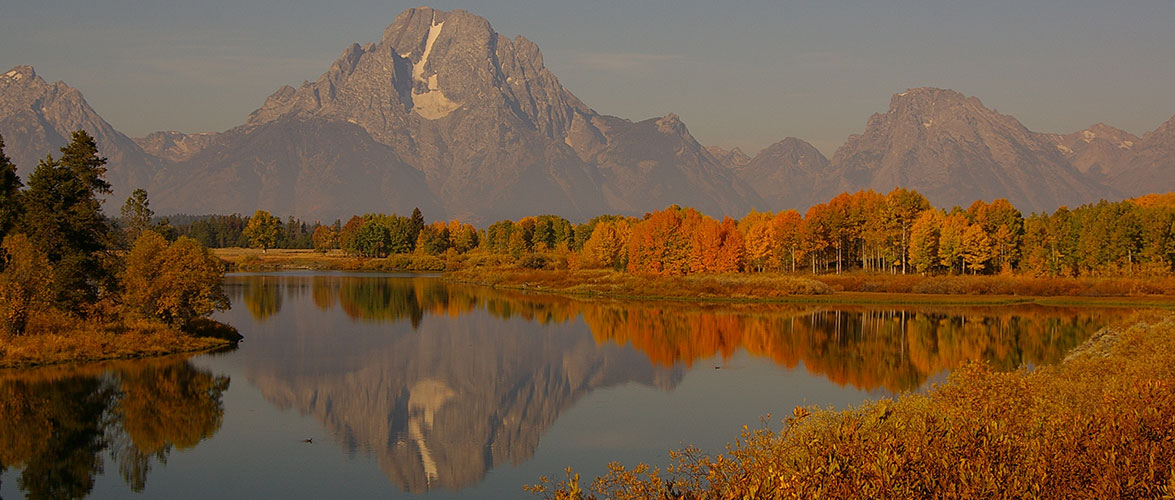The peaks—cathedral spires rising from the flat valley bottom. The river—intertwined trout-filled channels; the sage-brush flats spotted with free-roaming antelope and bison; the misty pre-dawn meadows shadowed with silhouettes of bull elk; the willow marshes screening hulking bull moose. The small-town charm; the unparalleled mountain resorts; the visual and performing arts that are as creative as this place is wild. The Travel and Tourism Board (TTB) has woven a spectacular narrative, the Stay Wild campaign, a narrative that borders on myth.
Or maybe is myth?
Marketing? Myth? Both? Myth: landscapes, heroes, creatures, feats and deeds bigger than life—cultural ideals. Myths are memorable, evocative, durable and believable. But only if rooted in fact. And what are the facts behind staying wild?
Teton County and the Town of Jackson, through citizen input, crafted and implemented the Jackson | Teton County Comprehensive Plan as the over-arching policy statement guiding growth, development and land use. At its core the Plan strives to protect the highest priority community values (a healthy ecosystem, a thriving economy, a vibrant community). Most communities prioritize only the latter two. Teton County not only places the three on equal pedestals but emphasizes that a healthy ecosystem underpins the latter two: our economy and our vibrant and diverse community rely on the vast array of ecosystem services delivered by a healthy, functioning ecosystem. And the Travel and Tourism Board’s Stay Wild campaign sums it up brilliantly, concisely and with elegance: stay wild.
But to stay wild we need wild—both wildlife and wildlife habitat. And to stay vibrant and creative we need artists. To that end, our town and county governments have put in place myriad policies and practices, often in partnership with private efforts, that lay the foundation for a vibrant and sustainable community. They are as broad-sweeping as the Integrated Transportation Plan and as minor as ensuring offices are provided with adequate bins to sort recycling. They include efforts to fund roadside signs to slow drivers and make them more aware of wildlife, to facilitate wildlife movement across private property, to preserve and improve water quality, to get people out of cars onto bikes and into busses, to promote the arts and early childhood education, to make our community age friendly, to preserve historic character, and to reduce our waste stream. It is because of these efforts, supported by thousands of hours and many hundreds of thousands of private dollars, that our community can rightfully claim that we are doing our best to stay wild.
But the TTB, the creator of Stay Wild, the number one promoter of our wild character, falls short of funding these very resources, the very people and organizations, the conservation efforts, the sustainability initiatives, the partnerships, that form the core of our most important values, the seeds of the myth that is Jackson Hole. Why?
It’s possible the board feels constrained by an interpretation of state law that is wildly (pun intended) off the mark when it comes to the definition of promotion.
As mandated by law, 60% of the roughly $7 million in funds generated by the 2% tax on all lodging expenditures should go towards efforts that are or that strongly relate to tourism promotion. An opinion (and only an opinion) by the Wyoming State Attorney General (AG) speaks specifically to funding “concerts, grooming ski trails and plowing roads,” stating that those are not allowed by the lodging tax statute. That’s not what we’re talking about. We’re talking about promotion, and here the opinion states that “’promotion’ in the context of the statute appears (AG’s emphasis) to have a narrow meaning more synonymous with advertise or publicize” and explicitly includes “promotional materials.”
And how do professional marketers (who have asked to remain anonymous) with nationwide clout create “promotional materials”? “By definition, any activity or investment that is designed with the intent to increase differentiation, visibility and awareness among an audience is, literally, branding and promotion.” So long as there is a clear strategic intent with “a promotional layer,” then “any program or project you invest in, it can be considered promotion,” no matter whether it is an investment in famous people, or sustainability initiatives or conservation efforts or arts councils. Other experts weighed in to the effect of “The “traditional” definition of marketing and branding – as defined in the AG opinion – is more than 20 years out of date…” while noting, “a critical advantage that Jackson Hole has over other mountain destinations is our abundant wildlife.” And, one might quickly add, includes our wildly creative arts community that generates over $50 million in economic activity.
In short, the AG’s opinion in no way constrains the TTB from deploying promotional dollars to invest in critical efforts to sustain our wild and wildly creative character. With a clear strategy, such as a campaign to Stay Wild, and a clear link to a bonified visitor experience, then investments in our highest community priorities is promotion. Save the bighorn so that when you ride the tram to the top of Rendezvous Peak you might see a bighorn. It’s that simple. Save the wild, film the effort to save the wild, and bingo you have some of the best Stay Wild marketing money can buy. Fund it, film it, let Instagram do the rest. Marketing 101—aka myth making.
Indeed the TTB already does some of this. They just do so in a limited, I would say timid, way. The TTB’s 2019 budget estimated revenues (these are 60% of total collections) at around $4.3 million. Of that it committed $200,000 to “local marketing partnerships.” This money, in the words of their budget, “funds the marketing efforts of local community organizations, for example, the Center for the Arts, JH Wild, Nordic Alliance, JH and Yellowstone Sustainability, so they can create and spend media in their areas of expertise and tell their brand and community story with the guidance of the TTB creative agency. Examples of recent work include the Wildly Creative campaign, JH Wild, Wild on Tour promotional video, Trip Advisor Green Leader and BEST certification and the Nordic Alliance Trail maps, website, Turpin Meadow Free Ski day and marketing initiatives. This initiative has also created community assets that can be used now and into the future.”
But there’s so much more than can be done. That line item could easily breach half a million dollars and still fall short. Why not include some of the genuine, community-led efforts that have measurable impacts in achieving community sustainability goals and that have strong symbolic value to drive the ‘stay wild’ narrative? Why not underwrite a portion of the multi-organization effort to restore river and stream water quality, or the multi-agency effort to save the high Teton bighorn sheep from extinction, or the partnerships that bolster and ensure a thriving arts community?
Jackson | Teton County have something no other rocky mountain community in the lower 48 have: an inimitable combination of scenery, history, thriving arts and small-town character ensconced in the center of the largest intact ecosystem in the lower 48 states. But are we the community with the motto ‘Stay Wild’ when in actuality we allowed Teton bighorn sheep to become extinct? Or didn’t prevent Fish Creek from becoming choked with algae? Or failed to support the artists that celebrate our rich community and amazing place with their work? Let’s support the TTB to do even more with valuable lodging tax dollars so that that doesn’t happen. The TTB has a talent pool that would make be the envy of a New York City ad agency. Let’s give them the policy-level support they deserve and unleash their best. Let’s do it for the sake of the community. Let’s do it for the sake of the ecosystem.


Mark, how do you see the prospective idea from the Govenor’s Office re: State Govt. usurping Fed. Gov. Environmental Quality rules to it’s own end. Re: Angus Theurmer’s piece in WyoFile. Thank you for doing this important local work. Martha Saxe( formerly Little)
Number one concern is that ecosystems cross state lines and the management agencies should have the authority to manage across state lines. Number two concern is state politics.
Did we allow the Big Horn Sheep to become extinct? I saw a pretty large herd this winter at the Elk Refuge where people created a very accessible food supply in a much less strenuous environment.
Thanks for the question Jake. The bighorn sheep are not extinct. The Sheep on the elk refuge are a genetically distinct species from the unique species that inhabits the high peaks of the Tetons. The species in the Tetons is the one at risk of going extinct and is down to between 50 to 80 animals. Wildlife biologist’s from the game and fish, grand Teton national Park, and Bridger Teton national forest are trying to organize a multi agency effort to save the population from further declines. But they need funding for the effort, and because it is a multi agency effort it has been hard for anyone agency to come up with funds for the effort. Having a photographer and or videographer along as the biologists go out and collar bighorn sheep to track their movements with made great footage for a “stay wild“ marketing campaign